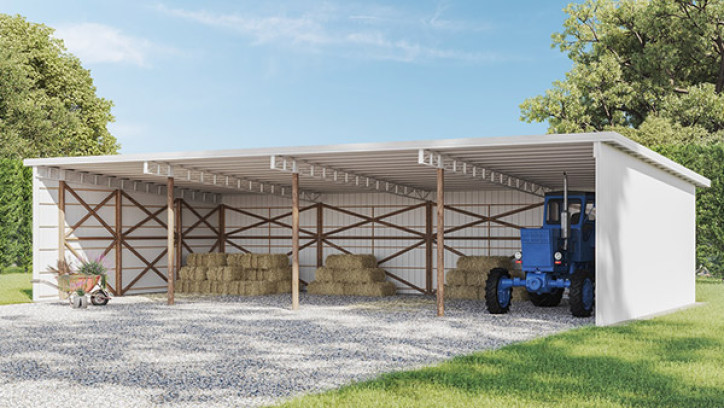2.7. Single-storey pole sheds and hay barns in rural zones – Licensed Building Practitioner

Pole sheds and hay barns can be enclosed, semi-enclosed or open structures which are used for farming activities in rural zones. They commonly house livestock, such as cattle and horses, as well as equipment and fodder, and often grain.
Before you begin, please read the notes for single-storey pole sheds and hay barns (particularly District Plan requirements).
There is no restriction on the type of material used, however, additional professional advice may be needed when using construction materials or methods that the Licensed Building Practitioner (LBP) is unfamiliar with.
To use this exemption, an owner must engage a LBP to design, build and/or supervise the build of the hay barn or pole shed, as long as the net floor area does not exceed 110 square metres and the building work is carried out in accordance with the design.
Owners are encouraged to seek LBPs with the right competence for this work, as this provides the best assurance.
The design work is best carried out by an LBP holding a Design licence. The construction work is best carried out by an LBP in one of the following licensing classes, as may be relevant to the building work planned to be undertaken:
- Bricklaying and blocklaying
- Carpentry
- External Plastering
- Foundations
- Roofing
You should also check the applicable public register for any registered professional you engage (for example, Registered engineer, Chartered Professional Engineer etc) before you engage them to carry out work under this exemption.
If supervision is being provided by a Licensed Building Practitioner under this exemption, that supervision must align with the Practice Note issued for Supervision by LBPs, which can be found at www.lbp.govt.nz.
What is exempt
- A rural farm owner wants to erect a hay barn with a net floor area of 80 square metres and with a maximum height of 3.6 metres. The proposed barn will be located 5 metres from the existing farm house. The site as a high wind zone. As the owners have contracted a licensed building practitioner to carry out or supervise the design or construction work, a building consent is not required.
What needs consent
- An owner of a farm in a rural zone wants to build a pole shed with a net floor area of 135 square metres. A building consent is required because the net floor area exceeds 110 square metres.
- A farm owner wants to build a 95 square metre hay barn on their rural property. The barn roof has an unsupported span of 7.5 metres, which exceeds the 6 metre maximum span allowed under this exemption and therefore requires a building consent.
- An owner of a farm in a rural zone wants to build a pole shed with a net floor area of 100 square metres to store small agricultural equipment. The building site is in an extra high wind zone. A building consent is required because the wind zone exceeds a "high" rating.
- An owner of a farm in a rural zone wants to build a pole shed with a net floor area of 100 square metres to store some agrichemical, solvents or similar products which meet the hazardous classification criteria according to the Health and Safety at Work (Hazardous Substances) Regulations 2017. A building consent is required because the hazardous substances can create significant risk and are outside the scope of this exemption.
What the law says
4A. Single-storey pole sheds and hay barns in rural zones
1. Building work in connection with a pole shed or hay barn in a rural zone if—
(a). any design or construction work is carried out or supervised by a Licensed Building Practitioner; and
(b). the building—
(i). is not more than 1 storey (being a floor level of up to 1 metre above the supporting ground and a height of up to 4 metres above the floor level); and
(ii). does not exceed 110 square metres in floor area; and
(iii). is not accessible by the public; and
(iv). is not used to store hazardous substances within the meaning of that term in regulation 4 of the Health and Safety at Work (Hazardous Substances) Regulations 2017; and
(c). the maximum unsupported roof span in any direction does not exceed 6 metres; and
(d). either—
(i). the design wind speeds do not exceed 44 metres per second (calculated using Verification Method B1/VM1); or
(ii). the building is located in a wind zone no greater than high (as defined in Acceptable Solution B1/AS1).
2. However, subclause (1) does not include any building work in connection with a building that is closer than the measure of its own height to any residential building, public road, railway, or legal boundary.